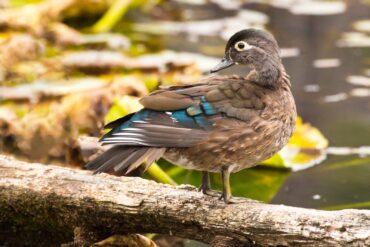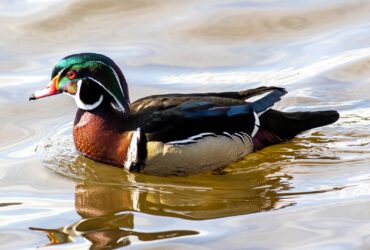
As is typical with many things in life, when it comes to birds, people gravitate toward the ones with visual beauty. While birders are thrilled to see a drab-looking rarity, nonbirders get excited about birds that look the best. Not surprising, colorful birds are the ones that turn the most heads.
The most visually stunning birds are usually tropical songbirds and hummingbirds. When considering colorful bird species, waterfowl don’t usually come to mind. It may surprise some then that in Washington, the most colorful native bird is a small duck.
With the scientific name Aix sponsa, which can be loosely translated as “waterbird in bridal dress,” the wood duck puts on an impressive show. The multicolored male makes a splendid appearance with red eyes, a chestnut chest, dark back, blue wing tones, iridescent green crested head, buffy sides, splashes of purple and striking white striping between the color patches. The female is a more subtle brown, although a bit more colorful than most female ducks, with blue wing feathers, a cap that shines iridescent green in direct light and a white teardrop eye ring.
About half the size of a mallard, the wood duck is the only known close relative of East Asia’s spectacular mandarin duck. The wood duck resides exclusively in North America, primarily inhabiting the western and eastern United States, where it lives year-round. Some populations that breed in southern Canada and the northern United States winter in the southern U.S. and Mexico.

Often shy around humans, the wood duck favors wooded swamps, ponds and lakes, especially those with heavy vegetative cover along the water’s edge. In West Sound, any lake or pond with wooded habitat along the shore offers a good chance of finding them, usually in pairs or small flocks.
The wood duck is one of the few species of ducks with strong claws, allowing it to grip tree branches. It’s a dabbling duck, and its diet consists of aquatic plants, seeds, nuts, fruit and arthropods. Rather than quacking like many other ducks, wood ducks are known for squealing to communicate. They’re capable of flying up to 30 mph.
The wood duck is unusual among waterfowl, nesting in natural cavities and nest boxes near or above water. It’s the only North American duck that regularly raises two broods per year. Clutch size is usually six to 10 eggs. However, a nest may hold up to 40 eggs, as females will lay their eggs in an occupied cavity if they can’t find one for their own use.
Wood ducks require large cavities for nesting, with an entrance hole 3 to 4 inches across. They typically utilize old nests dug out by pileated woodpeckers. Since natural nesting areas are scarce, wood ducks may use appropriately sized nest boxes attached to trees, placed near a pond or lake.
Following their mother’s call, newly hatched ducklings leap from the nest to the forest floor below, sometimes covering a distance of 50 feet. The ducklings bounce off the leaf litter and soft dirt unharmed, then follow their mother to the nearest water. Fledglings are capable of flight after eight weeks.
Wood ducks are a fairly common species, thanks to conservation efforts, without which the species may have gone extinct. From the late 1800s to the early 1900s, wood ducks had fallen victim to increased habitat loss and unlimited hunting that decimated populations. Wood duck meat was widely consumed and feathers were used for fishing flies, filling pillows and mattresses, and adorning ladies’ fancy hats.
In 1901, ornithologist George Bird Grinnell noticed the alarming decline and stated that “wood ducks are becoming very scarce and are likely to be exterminated before long.” At about this same time, the most abundant bird in North America, the passenger pigeon, had become extinct in the wild. In 1914, the last captive bird died at the Cincinnati Zoo. Passenger pigeon flocks of the Northeast once numbered in the billions. Commercial hunting had led to decimated populations from which the species, which relied on massive nesting colonies, could not recover.
The U.S. government realized that something had to be done so other species, like the wood duck, don’t follow the demise of the passenger pigeon. In 1918, Congress passed the Migratory Bird Treaty Act, which gave protections to native bird species, including hunting regulations. It’s considered one of the most crucial acts of environmental legislation ever enacted.
From 1918 to 1941, wood duck hunting was banned. Gradually, wetlands were restored, increasing habitat. Nest boxes were utilized. Today, thanks to these forward-thinking efforts, the wood duck is considered “a species of least concern.”
Wood ducks are stunning birds. Each one is a survivor of a prevented tragedy and a reminder that conservation isn’t a thing of the past, but is ongoing. May we all do our part.



























